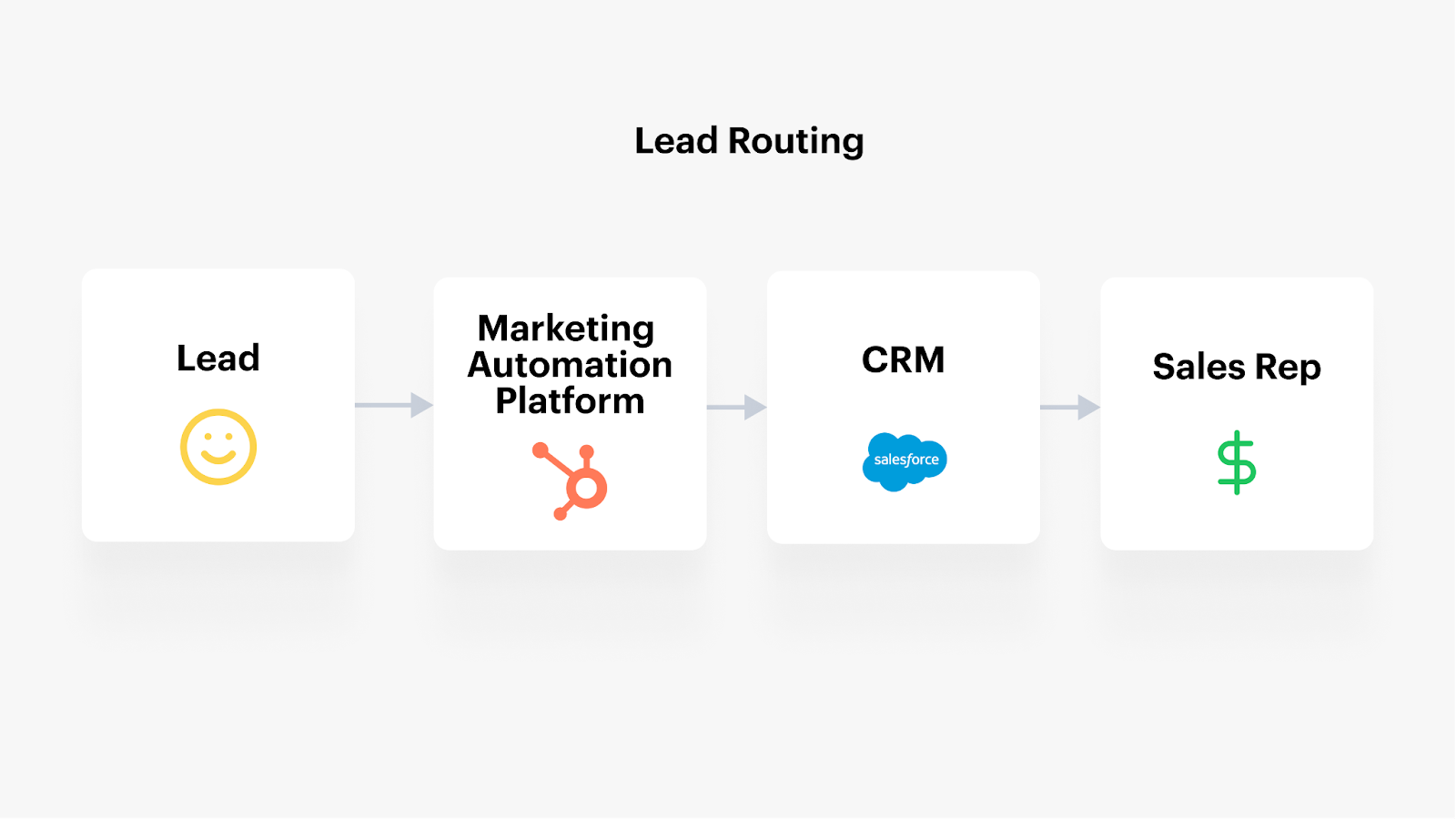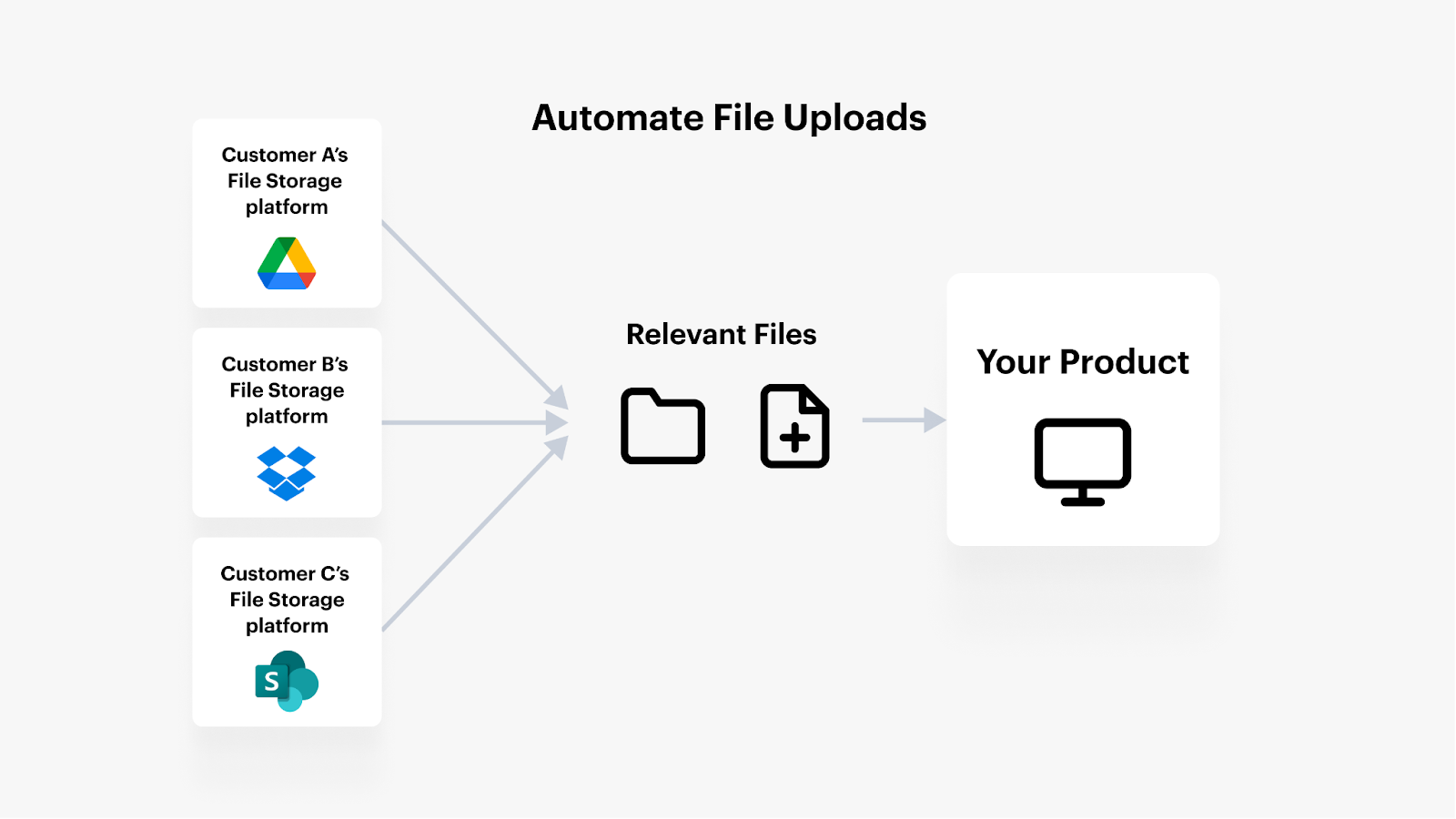Cloud-to-cloud integration: types, examples, and benefits

As organizations continue investing in more cloud-based applications, the need to integrate them will only grow.
But how, exactly, can you integrate cloud applications with one another? What are the different use cases to consider? And what are the benefits from implementing these integrations?
We’ll tackle all of these questions head on, but we’ll start by defining what cloud-to-cloud integration means.
What is cloud-to-cloud integration?
It’s the process of connecting cloud-based applications with one another, typically through their APIs. Once connected, the cloud applications can share specific data with one another in predetermined time-based intervals or in near real-time.
Related: What is two-way API integration?
Types of cloud-to-cloud integration
There are two forms of cloud-to-cloud integration to consider: internal, or “direct”, integrations, and product integrations.

Internal integrations simply refer to any integrations you build between the applications your teams use. For instance, it can be integrating your marketing automation system with your CRM to keep lead data consistent and up-to-date across both applications.
Product integrations, or customer-facing integrations, involve integrating your product with the applications your clients use. For example, you can integrate your product with clients’ HRIS solutions in order to automate user provisioning and deprovisioning in your product.
For the purposes of this article, we’ll cover both forms of cloud-to-cloud integration.
Examples of cloud-to-cloud integration
Here are just a few examples of cloud-to-cloud integration:
Route warm leads to reps quickly
Once a lead is ready to consider your solution, you’ll want the assigned sales rep to reach out quickly and incorporate a thoughtful message in their outreach.
To accomplish this, you can integrate your cloud-based marketing automation platform (e.g. Marketo) with your cloud-based CRM (e.g. Salesforce) and build a sync where once a lead reaches a certain score in the former application, they’re added to the latter in, or near, real-time.

Deliver personalized follow-ups to prospects
As clients navigate an e-commerce site, they may come close to making a purchase. For example, they might land on the checkout page, only to leave your site; or they may browse several product pages before exiting.

To re-engage these prospects and encourage them to make a purchase soon after shopping at your site, you can integrate your e-commerce platform (e.g. Shopify) with your marketing automation solution and build a workflow where visitors who exhibit certain behaviors (e.g. exiting the checkout page) get added to a specific campaign in the latter solution automatically.
Related: Examples of cloud integration
Enable clients to add files to your product seamlessly
Let’s assume your clients need and want to integrate their file storage solution with your product so that they can instantly access specific documents within your product and not have to worry about manually updating them.
To help facilitate this, you can integrate your product with a number of popular file storage solutions your clients use, like Box, Dropbox, Microsoft Sharepoint, and Google Drive. From there, you can either help clients sync all their files or enable them to pick and choose the ones they sync.

Related: Impactful software integration use cases
Help recruiters source and engage with ideal candidates
Say you provide a solution that uses AI to help organizations identify strong candidates for specific roles.
To make these recommendations easy for recruiters to access and act on, you can integrate with clients’ ATS solutions, like Greenhouse, Lever, and iCIMS, and build a sync where once a candidate is approved by a recruiter in your product, they’re automatically added to the recruiter's ATS solution.

Cloud-to-cloud integration benefits
Here are some of the top benefits of cloud-to-cloud integration:
Opens up revenue opportunities
Offering the external integrations your clients and prospects want can open up a variety of revenue streams.
Many of your existing clients will be willing to pay more to access the integrations; prospects will be, all else equal, more likely to choose you, especially if your rivals fail to provide the integration(s); and since integrations enable clients to get more value from your platform, they’ll be more likely to renew.
Our research on hundreds of product managers and engineers proves just how pervasive these benefits are:

Enables employee productivity
In the case of internal integrations, your employees no longer have to copy and paste data across applications or hop between systems just to find information. This will save them countless hours over time, and it’ll enable them to avoid the productivity drain that comes with reorienting themselves to a new interface.
With all these time savings, your team can re-allocate a significant chunk of their days toward more impactful tasks.
Enhances the employee experience
By allowing employees to avoid tedious, time-consuming, and error-prone tasks, like data entry, you’re also allowing them to focus on the more strategic, thoughtful work they value and enjoy instead. This not only results in an improved employee experience but also allows your business to benefit in the form of lower absenteeism, employee turnover, and even higher productivity.
Prevents excess spending
As organizations adopt an ever-growing number of SaaS applications, many of their investments are, in fact, unnecessary. An employee may be unaware that internal tools already offer the data and functionality they need simply because these systems aren’t connected to those used by the employee.
Related: The benefits of SaaS integration
Cloud-to-cloud integration challenges
Unfortunately, integrating cloud applications with one another can come with significant obstacles.
For example, our research has also found pervasive challenges when it comes to building integrations:

And when it comes to maintaining integrations:

Let’s cover just a few of the most common integration challenges:
Integration performance
As you build integrations, you’ll likely need them to sync data quickly, reliably, and at scale. This can prove to be technically challenging—if not impossible—for your team to accomplish.
An integrated application, or a feature within an application, gets discontinued
Keeping tabs on individual applications or features can be difficult to manage at scale. In addition, many applications fail to announce this information to a broad audience with enough advanced notice.
Given these factors, identifying when applications or features are getting deprecated and responding on time can prove difficult.
Difficult to scale
Each integration build can take your developers weeks, if not months. Moreover, since integrations routinely break, your developers end up spending even more time on maintaining them. Taken together, the prospect of adding more integrations over time can be a serious challenge for your team.
Challenging to secure partnerships
Some API providers require you to invest significant sums of money to access their API documentation. On top of that, these providers may end up rejecting your partnership application because they see you as a competitor, don’t understand how you can add value to their business, want to reduce their server load, etc.
API documentation is hard to access
Many API providers fail to make their documentation readily available. And even when it is, it’s often incomplete, out of date, difficult to navigate, and/or hard to follow.
This forces developers to rely on forums, their networks, and sheer trial and error.
Cloud-to-cloud integration best practices
Here are just a few best practices worth following:
Test all of your integrations comprehensively
Before you push any cloud integration to production, you’ll want to perform a wide range of integration tests that assess their reliability, security, scalability, etc.
To that end, you can perform load testing to suss out an integration’s ability to handle concurrent requests; scale testing to determine if the integration can process a high volume of data successfully; authentication and authorization testing to see if the integration handles a particular authentication method effectively—and so on.
Task developers with building and maintaining documentation on their builds
As your developers build and maintain certain cloud integrations, they should outline what they’ve done, why they’ve done certain things, when they’ve done them, etc. on a specific internal document that’s accessible to other members of the team. That way, when they leave, your remaining engineers can easily finish building an integration and/or maintain it.
Moreover, even if the engineers who work on an integration stay, they can forget a lot of details around the build, so documenting them can help refresh their knowledge over time.
Adopt a thoughtful process for evaluating and prioritizing integrations
While you may not receive an overwhelming number of cloud integration requests now, that can quickly change.
To ensure that your team consistently works on the most important cloud integrations for the business, you should establish the key performance indicators (KPIs) you need from your integrations and then estimate the impact of each integration in relation to these KPIs.
With these estimates on hand, deciding which integrations to prioritize (or whether one is worth building to begin with) is made all the more clear.
Cloud-to-cloud integration tools
As you look to begin implementing cloud-to-cloud integrations and you decide to use a 3rd-party integration tool, you’ll have a few different options to consider; they'll depend on whether you’re looking to build internal or customer-facing integrations.
Let’s review some common options:
Robotic process automation (RPA) software
An RPA tool uses scripts (or “bots”) to mimic human tasks at the user-interface level. This involves tasks like copying and pasting data between internal applications and adding attachments from an email to a specific location in an application.
The tool is ideal when you have fairly basic integration requirements, the applications’ UIs rarely change, and many of the applications don’t offer APIs. However, simple UI changes can break the bots, so they often require extensive maintenance over time.
Integration platform as a service (iPaaS)
An iPaaS lets you integrate your internal cloud applications and build automations that work across them.
The solution’s integrations are generally reliable and performant (as they use APIs). But the platform itself often requires technical expertise to use; moreover, it forces builders to implement one integration at a time, which makes it difficult to scale integration builds.
Embedded iPaaS
An embedded iPaaS is, essentially, an iPaaS that an organization adds to their product.
Depending on the vendor, an organization may be able to embed the solution in a way that's consistent with their application's branding (i.e. the integration appears to be built natively); otherwise, they'd simply add the embedded iPaaS' UI on top of the application via an iframe.

Like iPaaS, embedded iPaaS solutions are normally reliable. They also provide many pre-built connectors that can accelerate integration development.
That said, they have notable drawbacks. Namely, they require technical expertise to use; they only allow you to build integrations incrementally; and they fail to provide robust integration management tooling. Taking all of this together, it’s clear that embedded iPaaS tools prevent organizations from scaling and maintaining their integrations effectively.
Unified API solution
A unified API solution offers a single, aggregate API that lets an organization provide a whole category of integrations, whether that’s CRM, HRIS, ATS, file storage, etc.

Through Merge, the leading product integration platform, organizations can also maintain their integrations easily (our partner engineers handle this work on behalf of clients) and enable customer support teams to manage them via our suite of Integrations Management features.
You can learn more about Merge by scheduling a demo with one of our integration experts.







.svg)



